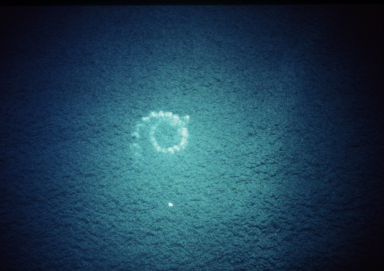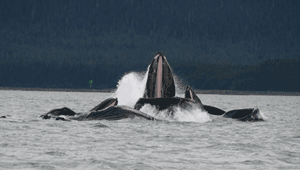Feeding behavior of Cetaceans
Cetaceans (whales, porpoises, and dolphins) can be split into two distinct groups based on the way that they feed. These two groups are toothed whales, suborder Odontoceti, and baleen whales, suborder Mysticeti.
Toothed whales are predatory species that use their teeth to help them capture food. Toothed whales commonly eat larger prey, including fish, squid, and sometimes other marine mammals. Baleen whales filter their food, typically large numbers of very small prey including plankton, krill, and other invertebrates (although sometimes they eat larger fish). They take in a large amount of food and water and partially close their mouths and push the water through their baleen. The food is trapped on the baleen, which the whale then takes off with their tongues and eat. To make up for the difference in size of these two types of food, baleen whales must eat a lot more small food items than the fewer, larger items a toothed whale eats.

Bubble net created by a humpback whale. Photo Credit: NOAA / NMML
Common terms and definitions
- Beaching
- Some species of dolphins and killer whales drive their prey up onto land to make them easier to capture. They will then purposefully beach themselves to capture the food and flop their way back into the water.
- Bubble net / Bubble clouds
- A method of feeding used by humpback whales, where the whales release nets or curtains of bubbles from their blowholes around a school of fish in an attempt to move them into a smaller area. When the bubble net is finished, encircling the fish, the whales swim up through the circle of bubbles with their mouths open and swallow the "trapped" fish. Using bubbles to push prey toward the surface to make them easier to capture is also a method that common bottlenose dolphins use to feed, but they haven't been documented using elaborate circles of bubbles.
- Echelon feeding
- Echelon feeding involves two or more cetaceans swimming in a "V" formation. One whale is typically in front and another is off to the side and slightly behind the first. This method may help funnel missed prey into the whale following behind. Bowhead whales (Balaena mysticetus) commonly use this method for feeding.
- Flick-feeding
- A method of feeding used by humpback whales. A whale will sit near the surface and slap its tail on the surface of the water. This behavior likely concentrates krill and other small prey in front of the whale. The whale then swims quickly through the area capturing the concentrated prey.
- Fishwhacking
- This method of capturing food was described for bottlenose dolphins. A dolphin will hit a fish with its fluke to stun capture and eat it.
- Lobtail feeding
- A behavior by humpback whales that appears to be a modification of the bubble net or bubble cloud. The whale uses its fluke to slap the water one or more times in a row. After the last splash, the whale dives and creates a bubble cloud in the same area. They then swim up through the cloud and consume the prey.
- Lunge feeding
- A method of feeding by baleen whales, which typically occurs at or near the surface. A whale moves rapidly through the water, they open their mouths and take in a large volume of water and food. They then close their mouths and push out the excess water filtering the food on their baleen.
- Kerplunking
- This method of feeding is used by dolphins to concentrate and/or disorient fish in an area by leaping in and out of the water and slapping the water surface with their tail.
- Skimming or skim feeding
- A method of feeding where a whale slowly moves through an area with abundant prey with its mouth partially open.
- Spyhopping
- A behavior when a cetacean raises its head above the water line presumably to look around, then sinks back below the water surface. Killer whales appear to use spy-hopping to find seals sitting on top of ice flows. After a seal is located, a group of killer whales may rush toward the ice and create a wave that tilts the ice and causes water to rush over the top. This sometimes causes the seal to fall off the ice pack and into the water where they can be eaten.

Lunge feeding by a humpback whale. Photo Credit: Aleria Jensen, NOAA/NMFS/AKFSC
Other Behaviors of Cetaceans
- Bow riding
- Bow riding is a behavior where dolphins and other marine mammals ride or surf the water that is pushed up in front of a moving boat or a large whale. The movement of water creates a pressure wave. It is unknown if there is any reason for this behavior or if the animals are just playing around.
- Breaching
- A behavior of whales and dolphins where they jump completely or partially out of the water and land on their belly, sides, or back making a large splash.
- Flippering / Flipper slapping
- When a cetacean swims on its side or back and hits the surface of the water with one or both flippers.
- Fluking
- When a cetacean holds their tail out of the water when they start to dive.
- Inking
- A behavior similar to that of an octopus, where species of whales discharge a large amount of feces. This cloud of reddish-brown waste blurs the view of a potential predator, from which they then swim or dive away. Pygmy sperm whales and dwarf sperm whales have been documented inking.
- Lobtailing
- A behavior where a cetacean slaps its fluke on the surface of the water.
- Logging
- A behavior in whales that occurs while they are resting. Individuals float at or near the surface, typically in large groups, all facing the same direction.
- Pitch poling
- A behavior in dolphins were they jump out of the water vertically (straight up), and land back on the surface of the water on their side. This creates a really large and loud splash.
- Roto-tailing
- A behavior in dolphins of rapidly moving their tails as they make a high leap out of the water.
- Tail-sailing
- A behavior seen in southern right whales (Eubalaena australis), where the whale raises its fluke out of the water and uses it as a sail allowing the wind to push them around.
References
Johnson, J.H. and A.A. Wolman. 1984. The Humpback Whale, Megaptera novaeangliae. Marine Fisheries Review. 46(4): 30-37.
Perrin W.F., B. Würsig, and J.G.M. Thewissen, eds. 2009. Encyclopedia of Marine Mammals. Academic Press, Amsterdam, p. 1316.
Weinrich, M.T., M.R. Schilling, and C.R. Belt. 1992. Evidence for acquisition of a novel feeding behavior: lobtail feeding in humpback whales, Megaptera novaeangliae. Animal Behavior 44: 1059-1072.
Wells, R.S., D.J. Boness, and G.B. Rathbun. 1999. Behavior. In Biology of Marine Mammals. Reynolds, J.E., III, and S.A. Rommel, eds. 324-422. Smithsonian Institution Press, Washington, DC.
Würsig, B., E.M. Dorsey, M.A. Fraker, E.S. Payne, and W.J. Richardson. 1985. Behavior of bowhead whales, Balaena mysticetus, summering in the Beaufort Sea: A description. Fishery Bulletin 83: 357-377.

 Marine Mammals of Georgia
Marine Mammals of Georgia